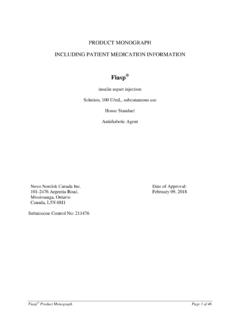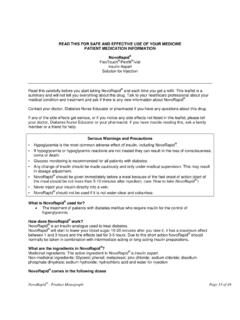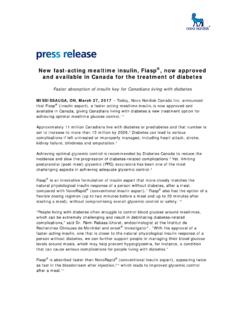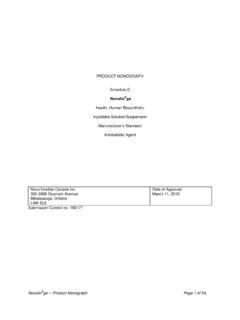Transcription of PRODUCT MONOGRAPH
1 PRODUCT MONOGRAPH . SAXENDA . liraglutide 6 mg/mL. Solution for injection in a pre-filled pen Human Glucagon Like Peptide-1 (GLP-1). Weight Management Novo Nordisk Canada Inc. Date of Revision: 300-2680 Skymark Avenue Mississauga, Ontario 12 July 2017. L4W 5L6. Submission Control No: 197571. SAXENDA ( liraglutide ) Page 1 of 47. Table of Contents PART I: HEALTH PROFESSIONAL INFORMATION .. 3. SUMMARY PRODUCT INFORMATION .. 3. 3. INDICATIONS AND CLINICAL USE .. 3. CONTRAINDICATIONS .. 4. WARNINGS AND PRECAUTIONS .. 4. ADVERSE 9. DRUG INTERACTIONS .. 14. DOSAGE AND ADMINISTRATION .. 16. OVERDOSAGE .. 17. ACTION AND CLINICAL PHARMACOLOGY .. 18. STORAGE AND STABILITY .. 20. SPECIAL HANDLING INSTRUCTIONS.
2 20. DOSAGE FORMS, COMPOSITION AND PACKAGING .. 20. PART II: SCIENTIFIC INFORMATION .. 21. PHARMACEUTICAL 21. CLINICAL TRIALS .. 21. TOXICOLOGY .. 29. REFERENCES .. 33. PART III: PATIENT MEDICATION INFORMATION .. 34. SAXENDA ( liraglutide ) Page 2 of 47. SAXENDA . ( liraglutide ). PART I: HEALTH PROFESSIONAL INFORMATION. SUMMARY PRODUCT INFORMATION. Route of Dosage Form / Strength Clinically Relevant Nonmedicinal Administration Ingredients subcutaneous Injectable, 6 mg/mL Disodium phosphate dihydrate, propylene glycol, phenol and water for injections. For a complete listing see Dosage Forms, Composition and Packaging section. DESCRIPTION. SAXENDA contains liraglutide , an analog of human GLP-1 and acts as a GLP-1 receptor agonist.
3 The peptide precursor of liraglutide , produced by a process that includes expression of recombinant DNA in Saccharomyces cerevisiae, has been engineered to be 97% homologous to native human GLP-1 by substituting arginine for lysine at position 34. liraglutide is made by attaching a C-16 fatty acid (palmitic acid) with a glutamic acid spacer on the remaining lysine residue at position 26 of the peptide precursor. SAXENDA is a clear, colourless solution. Each 1 mL of SAXENDA solution contains 6 mg of liraglutide . Each pre-filled pen contains a 3 mL solution of SAXENDA equivalent to 18 mg liraglutide (free-base, anhydrous). INDICATIONS AND CLINICAL USE. SAXENDA ( liraglutide ) is indicated as an adjunct to a reduced calorie diet and increased physical activity for chronic weight management in adult patients with an initial body mass index (BMI) of: 30 kg/m2 or greater (obese), or 27 kg/m2 or greater (overweight) in the presence of at least one weight-related comorbidity ( , hypertension, type 2 diabetes, or dyslipidemia) and who have failed a previous weight management intervention.
4 Limitation of Use: 1. Clinical efficacy and safety data from patients with BMI 27 to kg/m2 in the presence of at least one weight-related comorbid condition ( hypertension, type 2 diabetes mellitus, or dyslipidemia) are limited (N=149). Geriatrics ( 65 years of age): Patients 65 years may experience more gastrointestinal side effects when treated with SAXENDA . Therapeutic experience in patients 75 years of age is very limited. No overall differences in safety or effectiveness were observed between these patients and younger patients, but greater sensitivity of some older individuals cannot be ruled out. (See: SAXENDA ( liraglutide ) Page 3 of 47. WARNINGS AND PRECAUTIONS, Special Populations, Geriatrics).
5 Pediatrics (<18 years of age): The safety and efficacy of SAXENDA have not been studied in pediatric populations. SAXENDA is not indicated for use in pediatric patients (see WARNINGS AND PRECAUTIONS, Special Population, Pediatrics). CONTRAINDICATIONS. In patients with a personal or family history of medullary thyroid carcinoma or in patients with Multiple Endocrine Neoplasia syndrome type 2 (MEN 2), (see WARNINGS AND. PRECAUTIONS, Malignancies). Patients who are hypersensitive to liraglutide or to any ingredient in the formulation. For a complete listing, (see DOSAGE FORMS, COMPOSITION AND PACKAGING). During pregnancy or in breast-feeding women, (see WARNINGS AND. PRECAUTIONS, Special populations).
6 WARNINGS AND PRECAUTIONS. Serious Warnings and Precautions Risk of Thyroid C-cell Tumours liraglutide causes dose-dependent and treatment-duration-dependent thyroid C-cell tumours at clinically relevant exposures in both genders of rats and mice (see PART II, Toxicology Section). It is unknown whether liraglutide causes thyroid C-cell tumours, including medullary thyroid carcinoma (MTC), in humans, as human relevance could not be ruled out by clinical or nonclinical studies. SAXENDA is contraindicated in patients with a personal or family history of MTC and in patients with Multiple Endocrine Neoplasia syndrome type 2 (MEN 2). Based on the findings in rodents, monitoring with serum calcitonin or thyroid ultrasound was performed during clinical trials, but this may have increased the number of unnecessary thyroid surgeries.
7 It is unknown whether monitoring with serum calcitonin or thyroid ultrasound will mitigate human risk of thyroid C-cell tumours. Patients should be counselled regarding the risk and symptoms of thyroid tumours (see Contraindications, Warnings and Precautions, Adverse Drug Reactions and Toxicology). General The safety and effectiveness of SAXENDA in combination with other products intended for weight loss, including prescription drugs, over-the-counter drugs and herbal preparations, have not been established. SAXENDA should not be administered intravenously or intramuscularly. Never Share a SAXENDA pen Between Patients. SAXENDA pen should never be shared between patients, even if the needle if changed.
8 Sharing poses a risk for transmission of blood-borne pathogens. SAXENDA ( liraglutide ) Page 4 of 47. Cardiovascular The effects of SAXENDA on cardiovascular morbidity and mortality have not been established. Increase in Heart Rate: In the clinical trials, mean increases in resting heart rate of 2 to 3 beats per minute (bpm) were observed with routine clinical monitoring in SAXENDA -treated patients compared to placebo. More patients treated with SAXENDA , compared with placebo, have changes from baseline at two consecutive visits of more than 10 bpm (34% versus 19%, respectively) and 20 bpm (5% versus 2%, respectively). At least one resting heart rate exceeding 100 bpm was recorded for 6% of SAXENDA -treated patients compared with 4% of placebo- treated patients, with this occurring at two consecutive study visits for and , respectively.
9 Tachycardia was reported as an adverse reaction in of SAXENDA -treated patients and in of placebo-treated patients. In a clinical pharmacology trial that monitored heart rate continuously for 24 hours, SAXENDA . treatment was associated with a heart rate that was 4 to 9 bpm higher than that observed with placebo. (See ADVERSE REACTIONS, QTc in healthy Volunteers). The clinical significance of the heart rate elevation with SAXENDA treatment is unclear, especially for patients with cardiac and cerebrovascular disease as a result of limited exposure in these patients in clinical trials. Heart rate should be monitored at regular intervals consistent with usual clinical practice. Patients should inform their healthcare professional of palpitations or feelings of a racing heartbeat while at rest during SAXENDA treatment.
10 For patients who experience a sustained increase in resting heart rate while taking SAXENDA , SAXENDA should be discontinued. PR Interval Prolongation: A prolongation of the mean PR interval of up to 10 ms was reported with SAXENDA treatment in a clinical trial in healthy volunteers, using lower doses than recommended for weight management (see ADVERSE REACTIONS QTc in healthy volunteers). In healthy volunteers and in patients with overweight or obesity, the incidence of first degree atrioventricular (AV) block was higher with SAXENDA than with placebo (see ADVERSE REACTIONS, Cardiovascular disorders). The clinical significance of these changes is not fully known; however, because of limited clinical experience in patients with pre-existing conduction system abnormalities ( , marked first-degree AV block or second- or third-degree AV block) and heart rhythm disturbances ( , tachyarrhythmia), caution should be observed in these patients (see DRUG INTERACTIONS).


![[Product Monograph Template - Schedule D]](/cache/preview/b/f/c/5/9/9/f/5/thumb-bfc599f58969b8bff3fb0f7d9d95ed1e.jpg)



![[Product Monograph Template - Standard]](/cache/preview/f/9/7/c/8/1/3/1/thumb-f97c8131495ab4887eae21b91c1e72e4.jpg)




